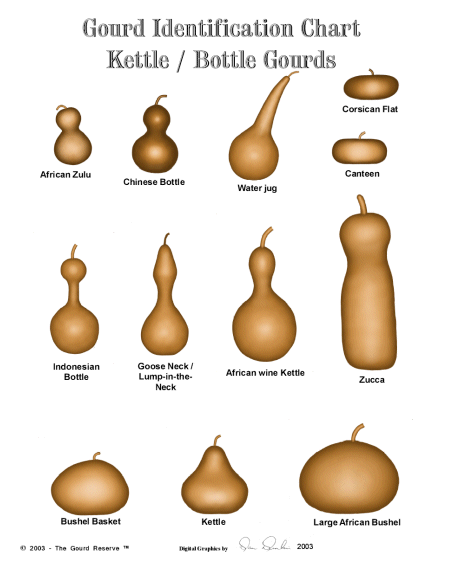| Online: | |
| Visits: | |
| Stories: |

| Story Views | |
| Now: | |
| Last Hour: | |
| Last 24 Hours: | |
| Total: | |
Gourds Today

 Gourds are well known today for their use in beautiful artwork and crafting. Historically gourds have been a part of many societies since ancient times. Used as bowls, vessels, bottles, spoons, musical instruments and tools; gourds have a unique place in our history.
Gourds are well known today for their use in beautiful artwork and crafting. Historically gourds have been a part of many societies since ancient times. Used as bowls, vessels, bottles, spoons, musical instruments and tools; gourds have a unique place in our history.
Gourds are mainly grown today to support the arts and craft market and decorative holiday market. But gourds can play an important part in your garden. Gourds can provide texture and variety to your garden. They are a great pollinator attractant and if you do have a creative side to you, the gourds can give you plenty of activities in the cold winter months.
Many hard-shelled gourds contain toxic amounts of bitter compounds called cucurbitacins. When harvesting seeds from gourds, working with them for crafts or using them for food storage, some basic precautions should be taken. The American Gourd Society offers some basic health guidelines for working with gourds, as well as a plethora of resources.
Gloves
Avoid direct skin contact with moldy gourds which have not yet been cleaned. Vinyl gloves like those used by the health industry can be purchased by the box at your local pharmacies and large chain stores. When scrubbing gourds, dishwashing gloves are recommended.
Mask or Respirator
Airborne dust particles and mold spores from gourds should be avoided just like any other type of airborne particulate. A mask or respirator designed to prevent inhalation of these minute particles should be worn when cleaning the outside surface, sanding, cutting, and cleaning inside surfaces of a gourd.Other Suggestions
Work with gourds outside whenever possible. If you must work inside, make sure you have good ventilation – and a dust control system is strongly recommended. Dust particles and mold spores will cling to clothing and hair. After working with gourds in the cleaning, sanding, cutting, and carving stages, change into clean clothes and wash the ones you were wearing. Keeping your hair covered while stirring up gourd dust or mold is also a good preventive measure.
If you are new to gourds, you will soon learn your sensitivities to them (if any), and the measures you’ll need to take when working with them. The first signs of a problem will most likely be a metallic taste in the mouth, fits of coughing, or sneezing with runny eyes and nose as in an allergy attack. The measures and protective items mentioned above are the first steps to maintaining good health while working with gourds.
Gourd Facts-
- A gourd is ready for harvest when the fruit’s stem changes from green to brown or yellow.
- Gourds must be stored in a cool dry location until completely dry. After it is dried the seeds will rattle when the gourd is shaken.
- To remove seeds from a gourd to use for crafting, you can drill a small hole in the stem or the blossom end.
- Gourds are heat-loving and need a long growing season.
- The rampant vines can be used to cover a fence, trellis and provide shade for some plants that could use some summer shade.
Here is a handy chart showing how to identify the different types of gourds that are grown.



Digital Gourds chart © Dan Dunkin 2003
This chart is used courtesy The Gourd Reserve
If you want some ideas to get your gourd inspiration going, Ginger Summit has written many books on crafting with gourds. There are some really cool ideas; we have many of her titles in our library.
Here is what we have to offer: help us preserve gourd bio-diversity by planting a seed today. Many varieties are being lost because they are no longer used in their traditional ways. Visit our selection of heirloom gourds to get started!
Source: http://www.underwoodgardens.com/slide-gardening-tips-and-tricks/gourds-today/?utm_source=rss&utm_medium=rss&utm_campaign=gourds-today



